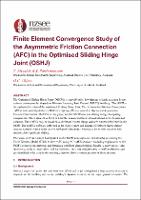Finite Element Convergence Study of the Asymmetric Friction Connection (AFC) in the Optimised Sliding Hinge Joint (OSHJ)

Download
Date
2023-04-19Authors
Alizadeh, Fatemeh
Ramhormozian, Shahab
Clifton, Charles
Metadata
Show full item recordAbstract
The Optimised Sliding Hinge Joint (OSHJ) is a cost-effective, low damage seismic resisting beam-column connection developed for Moment Resisting Steel Framed (MRSF) buildings. The OSHJ is the optimised version of the traditional Sliding Hinge Joint. The Asymmetric Friction Connections (AFCs) with partially deflected Belleville Springs (BeSs), named as Optimised Asymmetric Friction Connections (OAFCs) in this paper, are the OSHJ's friction sliding energy dissipating components, which also act as fuses to limit the seismic induced internal actions in the beams and columns. The OAFCs may be installed at the beam bottom flange and web bottom bolts level in the OSHJ. The OAFCs bolts are tightened in the elastic range and remain effectively elastic during seismic induced sliding under severe earthquake demands, retaining most of their installed bolt tension after significant sliding.
This paper provides a brief background on the OSHJ developments, followed by presenting the Finite Element Model (FEM) of the OAFC using ABAQUS software, including explanation of the FEM’s geometrical, material, and boundary condition characteristics. Finally, a convergence (aka sensitivity) study is undertaken, and the optimum mesh size and geometry as well as element type are identified, to be used in the ongoing extensive finite element analysis of these systems.
